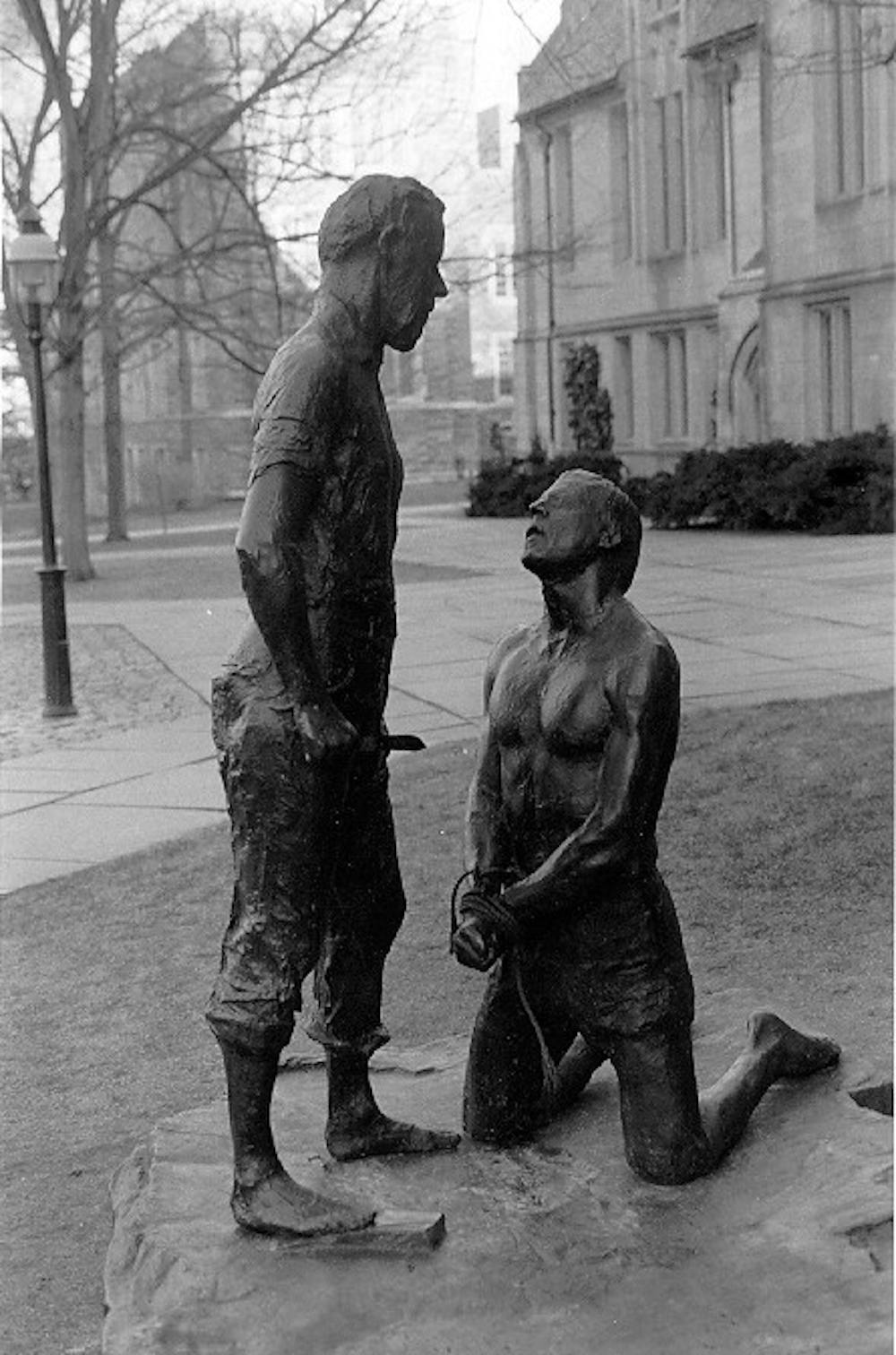Tucked behind the University Chapel, George Segal’s perennially misunderstood “Abraham and Isaac” depicts a bearded man brandishing a knife, preparing to slay a college-aged youth bound and on his knees. The piece’s poignancy and structural ambiguity invite double-takes and photographs. Among students and campus visitors, it has gained an unfortunate reputation.
To some, it’s simply that statue.
“Oh, that statue? Yeah, I know it,” said Benjy Jude ’23.
Others take a more critical angle.
“It does not look good from this direction,” commented a passerby.
And others were less tactful.
“Wait,” said Nate Moore ’22. “Are you talking about the blowjob statue?”
Despite these colorful interpretations, Segal’s work is firmly rooted in historical context. The piece was originally intended for Kent State University as a memorial for the infamous Kent State shooting, which occurred there on May 4, 1970. Segal chose the biblical story of Abraham and Isaac to express, in his words, “the eternal conflict between adherence to an abstract set of principles versus the love of your own child.”
“The dynamic of what’s happening between the two figures in the ‘Abraham and Isaac’ is not always obvious,” said James Steward, Director of the Princeton University Art Museum. “I’ve heard a number of interpretations posited, especially viewed from certain angles, which again is why I think in that case in particular it is important to note the context of what the backstory of the narrative happens to be to sort of discredit some of these superficial interpretations.”
In Segal’s own time, his work wasn’t without controversy. Kent State rejected the sculpture, questioning both its apparently violent imagery and questionable subject matter. The work was then donated to the University, where Segal taught sculpture from 1968-69. It now stands beneath the University Chapel, where it was first installed in 1974, along with a weathered label and the text of Genesis 22, which relays Abraham’s near-sacrifice of his son at God’s command.
“I was also a student here, so I used to walk by it all the time,” said Moulie Vidas GS ’09, a professor of Judaic studies. “It’s very evocative.”
Even to those on whom the piece’s historical associations are lost, the sculpture serves as an enigmatic landmark. Many alumni, faculty, and students find the piece provocative for thought, conducive to new interpretations — and, yes, a great spot for photos.

Across campus, the subject matter of art installations varies in intelligibility. Take the stern John Witherspoon, who scolds passersby from an alcove high on East Pyne Hall. The Witherspoon statue yields itself more easily to interpretation than the abstract “Oval With Points,” a favored photo-stop for tourists outside of Morrison Hall. “Abraham and Isaac” falls somewhere between them.
To some, it raises modern questions about intergenerational divides. Isaac, at the mercy of Abraham’s hands, may prove a particularly apt image in the age of “ok boomer.”
“I think some of the contemporary questions that it raises are about obedience versus resistance to authority, which is something we have to think about these days,” Vidas said. “You can take it to the place of the climate conflict, which is in some sense an intergenerational conflict. ‘Are we sacrificing our Isaacs for industry and capitalism?’”
Others see a story of forgiveness and compassion expressed in the bronze sculpture, which may assert universal claims about human behavior.
“Th[e] story [of Abraham and Isaac], of course, is classically one of forgiveness and compassion,” Steward said. “So I think it would be fair to suspect perhaps that that was part of the artist’s messaging.”
Others emphasize themes of obedience versus resistance, posing Abraham as the reluctant state punishing his rebellious son, while others are troubled by the work’s religious resonance.
As the Kent State tragedy’s 50th anniversary approaches this May, the question of where the sculpture resides has become more pressing.
“[‘Abraham and Isaac’] stands today, as it has for some 40 years, in exile on the campus of Princeton University,” wrote Werner Lange, a professor at Kent State from 1975-94, in a column for a Cleveland news site in 2018. “As we approach the 50th anniversary of this watershed moment in modern U.S. history, it is high time that this thought-provoking work of art be brought home from its foolishly imposed exile.”
While the homecoming of “Abraham and Isaac” remains uncertain, it is the statue’s mysterious aura that serves as its greatest appeal. Provocative both then and now, “Abraham and Isaac” elicits stronger reactions, ranging from shock to curiosity to discomfort, than many other pieces of campus art.
“[Campus art] is meant to interrupt the way that any one of us occupies and moves through space,” said Mitra Abbaspour, the Haskell Curator of Modern and Contemporary Art at the University Art Museum. “It can have many diverse intentions or ambitions after that to offer a space of contemplation, to provoke thought, to dwarf us as physical bodies, to cause us to feel our own mortality or fragility, to make us feel monumental, to give us a sense of, in fact, strength.”
On a college campus, pieces such as “Abraham and Isaac” possess the ability to spark engaging conversations about everything, ranging from resistance and forgiveness to the politics of fellatio and the climate crisis, and to serve as a means of stirring thought within the community.
“ ... Perhaps [public art] can become, again, fodder for conversation,” Steward said. “Presumably, we are here as part of an academic community because we want to have those conversations, and because we are absolutely happy to invite the public into that conversation too.”
The art museum plans to update the interpretative resources that accompany all campus art, including by providing more context and information about pieces such as “Abraham and Isaac.” Until then, visitors will be left to intuit the piece’s meaning for themselves.
“Abraham and Isaac” continues to stand in solitude, adjacent to the corner of William and Washington, inviting pedestrians to stop and ponder on their way up the steps to Firestone Plaza.








